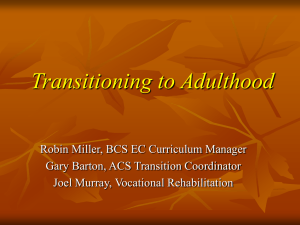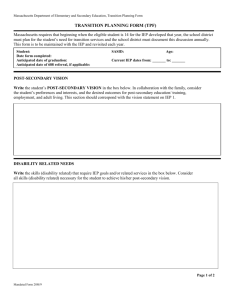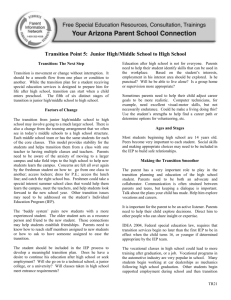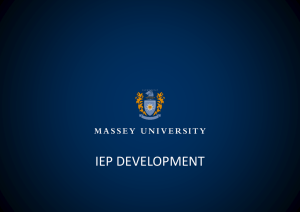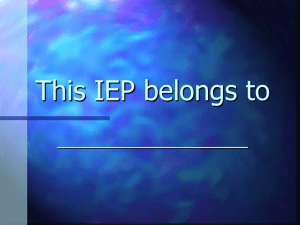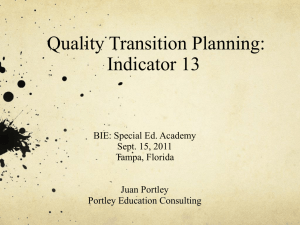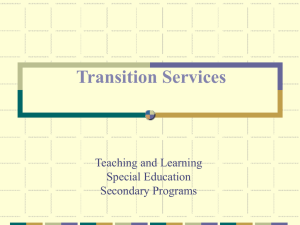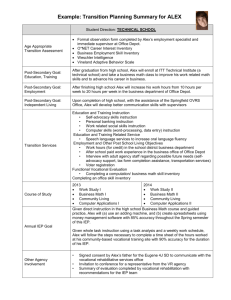Successful Transition Programming and Planning by Grade 9 and
advertisement
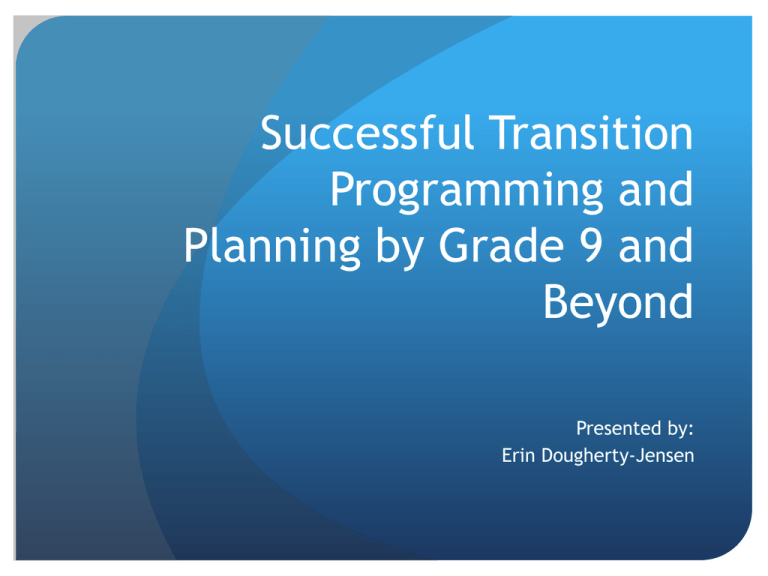
Successful Transition Programming and Planning by Grade 9 and Beyond Presented by: Erin Dougherty-Jensen Today’s Learning Targets Overview of Anoka Hennepin’s Data as it relates to 4 yr. graduation rates and percentage of students enrolled in transition programs. Review of the rules and regulations regarding transition planning for students receiving special education services. Options for students beginning in grade 9 and beyond with respect to transition programming. Process / criteria for determining what students are truly in need of specialized transition programming and planning beyond their 12th grade year compared to their non-disabled peers. Our Current Reality We are required to report the number of special education students we have in our transition programs to the MDE yearly. The statewide target (determined by the MDE) for students enrolled in and in need of transition programming is 4.4%. Anoka-Hennepin has been fairly consistent over the past few years at around 8.8%. Clearly, this is double the statewide target. With continued discussion and planning around this topic a plan and process will be put into place to bring AnokaHennepin’s percentage more in-line with the statewide target. Our Current Reality Continued… In review of the past few years, it is fairly consistent that the percentage of students receiving special education services that complete their 12th grade year and are awarded their diploma runs between 30%-50%. With that said, we are referring 50%-70% of students to our transition programs and not awarding them their diploma. There is not currently a uniform process that the district follows in respect to transition programming options, for identifying what students are in need of additional specialized transition programming and what their backward plan is once they are there. Secondary Transition Minn. Stat. § 125A.08 requires additional documentation in the IEP that provides an accountability framework for improving secondary transition services and outcomes. The statute also requires that this takes place by the end of grade 9 and yearly thereafter until the student is awarded their diploma. This is addressed within four components of the IEP: Desired Post-Secondary Outcomes, Anticipated Courses of Study, Other Transition Services or Activities and the Description of Child. Desired Post-Secondary Outcomes As mentioned before, the expectation is that by grade 9, a student’s IEP team discusses and develops a measurable post-secondary outcome that the student hopes to reach post grade 12 or transition program. Progress reporting is not required on an annual basis however the team needs to continue to address and discuss this outcome on a yearly basis as it may change from year to year. A post secondary outcome must be written for EACH student in the areas of employment and post-secondary and when appropriate, independent living. The team should also use these outcomes to drive the annual goals and services of the student. Desired Post-Secondary Outcomes MUST be written in the format of “the student WILL …” vs. “the student plans to or would like to” Examples of Acceptable PostSecondary Outcomes After graduation, Jamal will obtain a bachelor’s degree in computer science. After graduation, Maria will pursue an internship in the field of advertising while she attends postsecondary school part-time. After graduation, Danny will live in his own apartment in an assisted living facility. Examples of Unacceptable PostSecondary Outcomes After graduation, Danny will participate in a variety of indoor and outdoor leisure activities. After high school, Mia is unsure of what she would like to do as a profession. After high school, John is pretty sure he might go to school. Anticipated Courses of Study The IEP team needs to map out what courses a student is going to take during the year the IEP is written and at least one year beyond. (The team is encouraged to map out all four years if appropriate) These courses of study should directly relate to the child’s post-school outcomes. Be as specific in the course titles as possible as that clearly indicates what programming has been put in place to allow the student as much opportunity as possible to meet their desired outcomes. School Year Grade Courses of Study 2012-2013 9th Business Basics, Math Basics, Reading Essentials, Adapted PE, Environmental Science, Current Events 2013-2014 10th Business Basics, Consumer Math, Readings and Literature Citizenship, Speech and Drama, Social Skills, Specially Designed Employability Skills, Family Living 2014-2015 11th English for Work, Math for the World of Work, Specially Designed Communications, Specially Designed Daily Living Skills, Graphic Design 2015-1016 12th Specially Designed Communication and Writing Skills, Essentials of Business Operations, Computer Applications, Work Based Learning Other Transition Services or Activities Transition services must specifically address postsecondary goals and sufficiently enable the child to advance appropriately toward attaining their postsecondary goals. An activity can be done in collaboration with other participating agencies, including the student and family, and may not require specialized instruction. There is not the requirement that all activities are completed within that IEP year however it is required that if an activity was not addressed that the team discuss why it wasn’t and if it is still appropriate to continue that in the next IEP. Service Activities (Activities that are bold require an annual goal) Other Agency Responsible Instruction Participate in Business Basic class -Improve reading skills -Improve writing skills -Improve social skills and self-determination skills Regular Education Special Education/Related Services Vocational Rehabilitation, MnSCU Disability Coordinator Community Experiences -Acquire a state ID -Visit a Work Force Center -Visit Hennepin Technical College and meet Disability Coordinator Related Services -Complete application for county support and vocational rehabilitation program Improve Communication skills County Social Worker, Vocational Rehabilitation Services The development of employment and other post school adult living objectives: Memorize social security number Work Based-Learning Learn pre-employment skills Work Based-Learning If appropriate, acquisition of daily living skills and provision of a functional vocational evaluation: -Develop a personal fitness routine -Complete a vocational evaluation Student, General Education Special Education, Related Services Student, Vocational Rehabilitation Services With All of That Said… I’d like to have some discussion surrounding how and when transition programming is taking place for the students you case manage. Please group up (with others NOT in your building) and talk through what this looks like in your building. What do you feel works well and address the regulations What makes transition programming/planning in the high school years difficult Ten Sigma Transition Checklist Comments?? Common Themes for why Students are Attending… First and foremost…my disclaimer! Credit Deficient Transition Programs are not a credit recovery process Grades, especially within special education courses Wanting to get “free college” This is a misconception for many and the options for accessing some type of post secondary course work have many criteria “It would be good for”… We acknowledge that it would be great for many students (sped or not) to have additional support following high school however it should be more specialized and specific in nature for those attending. Transition components were not addressed in high school. Although it may not always be possible to meet all of a student’s transition needs during high school, it is the expectation that programming (with a backward plan in mind) needs to begin there. What Options Could be Explored in High School and Possibly Beyond.. For many years, the discussion and focus at high schools has been highly academic in nature as it relates to programming. For some special education students, that may be completely appropriate and inline with the desired post-secondary outcomes and for others, our “traditional” path is not structured in a manner that best meets their needs. Through the IEP process, we have the opportunity to explore options for our students to achieve those outcomes through means other than the “traditional” route. By programming and planning in that fashion, beginning in 9th grade, many of our students may have met their goals in all areas, including transition, by the end of their 12th grade year. Possible graduation via the student’s IEP versus credit/course specific completion. For those that are still in need of specialized transition programming, it will be clear what has taken place and what continues as a need. Process and Criteria for Determining What Students are in Need of Specialized Transition Programming After High School Case Mgrs will have documented, via the IEP, what transition programming and planning has taken place since the student’s 9th grade year. Beginning the 12-13 school year, I will be scheduling a full day in each of the high schools in September so case mgrs can bring the names of students they feel are in need of additional transition programming after high school. For students being referred to a transition program, the high school will work with the transition program to develop a backward plan for those students that clearly outlines what the student needs, how it will be addressed and by when. Is It Ever That Clean & Simple?? Of course it isn’t! We will continue to work on increasing our opportunities for addressing transition programming beginning in the high school years while ensuring those students that are being serviced in our transition programs are truly in need of a specialized transition program and plan that is clearly different than their non-disabled peers. Please, I encourage you to contact me with questions, concerns, suggestions, and ideas as it relates to this topic. Pathways… ???? Questions ???? THANK YOU


